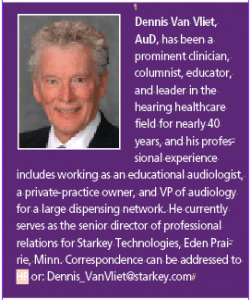Final Word | June 2014 Hearing Review
By Dennis Van Vliet, AuD
A patient I fit with a pair of canal hearing aids about 5 years ago contacted me a couple of weeks ago. I hadn’t seen him but once or twice in the time since I fit him. He reported that he had been “checked out” elsewhere, and needed his hearing aids “tweaked” a bit.
As soon as I heard his voice, I remembered him. An engineer, he works in the theme park industry and has applied his imaginative engineering skills to develop and maintain the park rides for most of his career. I was surprised to hear that he is still working, because he had discussed retiring and moving out of state within a year or so when I fit him 5 years ago. I enjoy him as an interesting patient, and we made arrangements to have him come in.
We went about the business of “tweaking” his hearing aids to bring his audibility up to an appropriate level. The aids were functioning well for the technology, and he reported that he had been pleased with them, except for not quite having the audibility he needed. He seemed satisfied with the adjustments we made during the visit that day.
Then he asked me an important question: “What has changed in hearing aid technology over the last 5 years?”
I was struck by the memory of how many times I have been asked that question over the past 38 years. Depending on the technology of the day, I have always answered that question in a straightforward manner, reciting the benefits of the features currently available. Before responding this time, I asked him a question. “We just finished discussing about how pleased you are with these hearing aids, and that all they needed was an adjustment. Why are you asking about new developments?”
He went on to discuss details about situations professionally and socially that were a problem for him. At that point, we had something to discuss that was very specific to his needs. I brought him up to speed on noise reduction, directional, and remote microphone technology, all of which would address his biggest complaints.
When we were done with the discussion and his follow-up questions, he announced that he wanted to proceed with being fitted with a new set of hearing aids that included the features we had discussed. “I’m going to be 85 this year and don’t want to be held back if there is technology that will make things better for me.” We set up a date for his return visit.
The Value of Trust
What had just happened? What made him look for me and not have the discussion with the facility where he had been “checked out?” It wasn’t sales because I never consciously went into that mode, and I’m not good at including sales as a goal with a patient visit.
I suspect it was trust, and confidence in services and products that he had received over time. Of course, there was a perceived need, or he wouldn’t have been there talking with me. How do we build that trust? How fragile is it?
Industry experts frequently discuss that we are in a relationship business more than anything else. I think that is largely true. Our basic skill sets must be appropriate to provide the care needed, but the relationship we build as we work with the patient and their significant others provides the long-term bond that encourages them to follow our treatment recommendations, and to come back to see us rather than another provider.
Building trust comes with determining what a patient needs, and guiding them along a treatment plan in a manner that demonstrates that we clearly understand and care about their difficulties. As we have learned since HMOs have become part of the healthcare landscape, loyalty can be fragile when a force larger than trust comes into play. The force may be the HMO referral network, or it may be convenience if things change in the patient’s world that make us inconvenient to do business with.
What trust can do is to motivate the patient to check with us before going elsewhere. That gives us the opportunity to offer alternatives, or to reinforce our bond with them.
The Final Word? We not only need to be technically skilled with the “hardware” aspects of hearing care, but skilled in the relationship “software” aspect of interacting with patients as we provide care. Doing so will not only provide the patient with the confidence to follow our treatment recommendations, but will also foster loyalty that will build the strength of our practice for the long term.
Citation for this article: Van Vliet D. Trust as the ultimate value proposition: Motivating patients to rely on you for their hearing care needs. Hearing Review. 2014;21(6):50.






